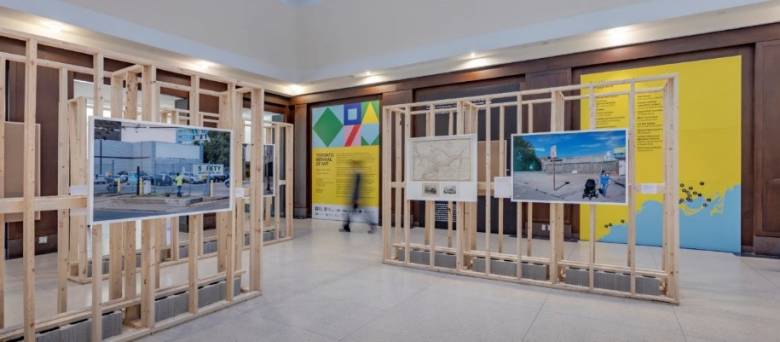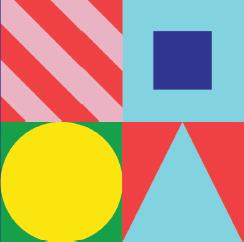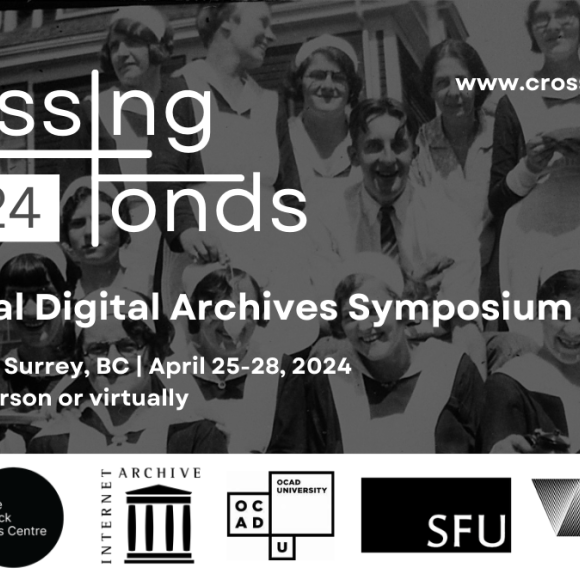Toronto Biennial of Art & OCAD U: The View from Here (2019), by Luis Jacob

Luis Jacob's The View from Here (2019)
The View from Here is a two-part installation by artist Luis Jacob located at 259 Lake Shore Blvd E and Union Station’s Oak Room from September 21 to December 1 for the inaugural Toronto Biennial of Art, 2019. Adopting maps, printed street-views, books, and the city’s landscape, Jacob’s installation explores many of Toronto’s conflicting narratives. As a central dynamic of the project, Jacob has invited a series of guest artists, researchers, and thinkers who, from their own research and practices, extend the context of his presented materials. From mapping forms of social storytelling, to understanding cultural belongings as repositories of relations, and working with printed matter as sites of neighbourhood organizing—each offering reveals another “view from here.”
Commissioned by the Toronto Biennial of Art and co-presented by OCAD University and Toronto Union with generous support from the Toronto Arts Council.
The View from Here with Simon Vickers
Monday, November 4, 2:00 pm – 4:00 pm
259 Lake Shore Blvd East
Simon Vickers researches intersections of public and urban history, focusing on activism across particular neighbourhoods in Toronto and Montreal since the 1960s. For this presentation, Vickers engages with Luis Jacob’s The View from Here to initiate dialogues on historical social movements and how the city has been impacted by gentrification, affordability and the role of printed matter in tracing those processes.
The View from Here with Fadi Masoud and Adrian Blackwell:
Reading a Moving Shoreline
Monday, November 18, 4:00 pm – 6:00 pm
259 Lake Shore Blvd East
Fadi Masoud is a landscape architect and planner who focuses on the relationships between large-scale environmental systems, dynamic design, and the instrumentality of planning policies. Adrian Blackwell is an artist, designer, and theorist interested in the relationship between political economy and the production of physical spaces. In the context of Luis Jacob’s The View from Here, and within Blackwell’s Isonomia in Toronto? (Harbour) (2019), Masoud and Blackwell discuss Toronto’s waterfront, drawing attention to the vulnerabilities of urban districts built upon reclaimed land, and the strategies available to mitigate the effects of climate change. Participants join in a mapping exercise, tracing the human and non-human actors transforming the shoreline, and through this activity, encourage a literacy of the interaction between the natural and operational forces creating urban space.
The View from Here with Bonnie Devine
Monday, November 25, 2:00 – 4:00 pm
Union Station, Oak Room
In response to various objects in Luis Jacob’s installation The View from Here, Bonnie Devine introduces a surveyor’s transit from her project Circles and Lines: Michi Saagiig (2018). View-finding instruments have been used since antiquity to mark out, allot, and regulate land, including the land of the Mississauga Nation that was transferred to the British in the Toronto Purchase of 1787, and the Toronto Indenture of 1805. Bringing Jacob’s sculpture The Riddle (2018) into conversation with the transit, Devine engages visitors in a discussion around cartography, ownership and the weaponization of the Colonial gaze.
About the Toronto Biennial of Art
Launching in fall 2019, the Toronto Biennial of Art (the Biennial/TBA) is a new international contemporary visual arts event that is as culturally connected and diverse as Toronto itself. For 10 weeks every two years, the city will be transformed by exhibitions, talks, and performances that reflect the local context while engaging with the world’s most pressing issues of our time. In an effort to make contemporary art available to everyone, the Biennial’s free, citywide programming aims to inspire people, bridge communities, and contribute to global conversations from a variety of perspectives.
For more information, visit: torontobiennial.org, @torontobiennial, @tbaprograms and #TObiennial19 on Facebook, Twitter, and Instagram, as well as the account exclusively for Programs.
About the Artists
Luis Jacob (born in Lima, Peru; lives in Toronto, ON, Canada) is an artist whose work destabilizes viewing conventions and invites collisions of meaning. He studied semiotics and philosophy at the University of Toronto. Since his participation in documenta 12, Kassel, 2007, he has achieved an international reputation with exhibitions at venues such as: La Biennale de Montréal, 2016; Tanya Bonakdar Gallery, New York City, 2015; Taipei Biennial, 2012; Generali Foundation, Vienna, 2011; Solomon R. Guggenheim Museum, New York City, 2010; Kunstverein in Hamburg, 2008; and Power Plant Contemporary Art Gallery, 2008.
Simon Vickers (born in Flatrock, NFLD, Canada; lives in Toronto, ON, Canada) research interests include public history, urban history, and the history of social movements. He has previously written about social and co-operative housing movements in Montreal, and is currently writing about neighbourhood activist movements in Toronto and Montreal since the 1960s. Simon is a PhD candidate in History at the University of Toronto.
Fadi Masoud is an Assistant Professor of Landscape Architecture and Urbanism at the University of Toronto and the Director of the Centre for Landscape Research Platform for Resilient Urbanism. He previously taught at Massachusetts Institute of Technology (MIT) and is an affiliated faculty at the MIT Leventhal Center for Advanced Urbanism, where he co-leads research and designed projects on coastal urbanism, urban codes, and the Future of Suburbia. His research, writing, design work, and teaching focuses on establishing multi-scalar and emergent relationships between landscape and planning principles, tools, and practices.
Adrian Blackwell (born and lives in Toronto, ON, Canada) is a settler artist, urban designer, theorist, and educator. Blackwell’s practice focuses on the relation between physical spaces and political economic forces. His work has been featured in exhibitions such as: Chicago Architecture Biennial, 2019; Chengdu Biennale, 2011; and Shenzhen Biennale of Urbanism\Architecture, 2005. He is Associate Professor of Architecture at the University of Waterloo and co-editor of the forthcoming issue of SCAPEGOAT: Architecture / Landscape / Political Economy titled “Delineating a Nation State.”
Bonnie Devine (Serpent River First Nation, born and lives in Toronto, ON, Canada) is a descendant of the Genaabaajing Anishinaabek (Serpent River First Nation) in Ontario. Her cross-disciplinary artwork emerges from traditional Indigenous storytelling and image-making methods and has been exhibited in Canada and internationally. She holds degrees in sculpture and installation from the Ontario College of Art and Design (now OCAD University) and York University and is the recipient of numerous awards, including a 2011 Eiteljorg Contemporary Art Fellowship. Devineisan associate professor emerita at OCAD University and the Founding Chair of OCAD’s Indigenous Visual Culture program.

